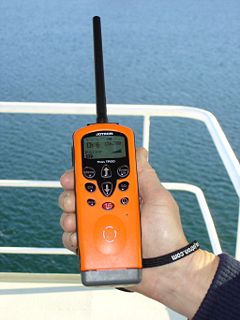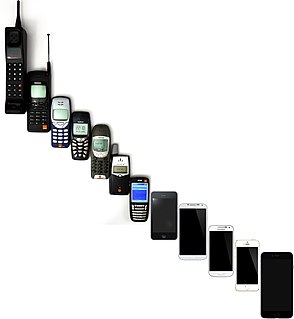Brazil has both modern technologies in the center-south portion, counting with LTE, 3G HSPA, DSL ISDB based Digital TV. Other areas of the country, particularly the North and Northeast regions, lack even basic analog PSTN telephone lines. This is a problem that the government is trying to solve by linking the liberation of new technologies such as WiMax and FTTH) only tied with compromises on extension of the service to less populated regions.
Telephony is the field of technology involving the development, application, and deployment of telecommunication services for the purpose of electronic transmission of voice, fax, or data, between distant parties. The history of telephony is intimately linked to the invention and development of the telephone.
Voice over Internet Protocol (VoIP), also called IP telephony, is a method and group of technologies for the delivery of voice communications and multimedia sessions over Internet Protocol (IP) networks, such as the Internet. The terms Internet telephony, broadband telephony, and broadband phone service specifically refer to the provisioning of communications services over the Internet, rather than via the public switched telephone network (PSTN), also known as plain old telephone service (POTS).
Enhanced 911, E-911 or E911 is a system used in North America to automatically provide the caller's location to 911 dispatchers. 911 is the universal emergency telephone number in the region. In the European Union, a similar system exists known as E112 and known as eCall when called by a vehicle.
Integrated Digital Enhanced Network (iDEN) is a mobile telecommunications technology, developed by Motorola, which provides its users the benefits of a trunked radio and a cellular telephone. It was called the first mobile social network by many technology industry analysts. iDEN places more users in a given spectral space, compared to analog cellular and two-way radio systems, by using speech compression and time-division multiple access (TDMA).

Wireless communication is the transfer of information between two or more points that do not use an electrical conductor as a medium for the transfer. The most common wireless technologies use radio waves. With radio waves, intended distances can be short, such as a few meters for Bluetooth or as far as millions of kilometers for deep-space radio communications. It encompasses various types of fixed, mobile, and portable applications, including two-way radios, cellular telephones, personal digital assistants (PDAs), and wireless networking. Other examples of applications of radio wireless technology include GPS units, garage door openers, wireless computer mouse, keyboards and headsets, headphones, radio receivers, satellite television, broadcast television and cordless telephones. Somewhat less common methods of achieving wireless communications include the use of other electromagnetic wireless technologies, such as light, magnetic, or electric fields or the use of sound.

Fido Solutions Inc. is a Canadian cellular telephone service provider owned by Rogers Communications Canada. Although Fido's parent company, Rogers Communications, also operates another cellular service Rogers Wireless, Fido remains a separate entity and retains its own retail chain, customer service call centres, network servers and CEO. Fido pioneered the concept of providing unlimited service in select Canadian cities. Fido was the first carrier in Canada to launch a GSM-based network and the first wireless service provider in North America to offer General Packet Radio Service (GPRS) on its network.
A landline is a phone that uses a metal wire or optical fiber telephone line for transmission as distinguished from a mobile cellular network, which uses radio waves for transmission.

Mobile telephony is the provision of telephone services to phones which may move around freely rather than stay fixed in one location. Telephony is supposed to specifically point to a voice-only service or connection, though sometimes the line may blur.

Mobile radio telephone systems were telephone systems of a wireless type that preceded the modern cellular mobile form of telephony technology. Since they were the predecessors of the first generation of cellular telephones, these systems are sometimes retroactively referred to as pre-cellular systems. Technologies used in pre-cellular systems included the Push to Talk, Mobile Telephone Service (MTS), Improved Mobile Telephone Service (IMTS), and Advanced Mobile Telephone System (AMTS) systems. These early mobile telephone systems can be distinguished from earlier closed radiotelephone systems in that they were available as a commercial service that was part of the public switched telephone network, with their own telephone numbers, rather than part of a closed network such as a police radio or taxi dispatching system.

The history of mobile phones covers mobile communication devices that connect wirelessly to the public switched telephone network.

Alltel Wireless was a wireless service provider, primarily based in the United States. Before acquisitions by Verizon Wireless and AT&T, it served 34 states and had approximately 13 million subscribers. As a regulatory condition of the acquisition by Verizon, a small portion of Alltel was spun off and continued to operate under the same name in six states, mostly in rural areas. Following the merger, Alltel remained the ninth largest wireless telecommunications company in the United States, with approximately 800,000 customers. On January 22, 2013, AT&T announced they were acquiring what remained of Alltel from Atlantic Tele-Network for $780 million in cash.

Sprint Corporation was an American telecommunications company. Before it merged with T-Mobile US on April 1, 2020, it was the fourth-largest mobile network operator in the United States, serving 54.3 million customers as of June 30, 2019. The company also offered wireless voice, messaging, and broadband services through its various subsidiaries under the Boost Mobile and Open Mobile brands and wholesale access to its wireless networks to mobile virtual network operators.

Tethering, or phone-as-modem (PAM), is the sharing of a mobile device's Internet connection with other connected computers. Connection of a mobile device with other devices can be done over wireless LAN (Wi-Fi), over Bluetooth or by physical connection using a cable, for example through USB.
Generic Access Network (GAN) is a protocol that extends mobile voice, data and multimedia applications over IP networks. Unlicensed Mobile Access (UMA) is the commercial name used by mobile carriers for external IP access into their core networks. The latest generation system is named Wi-Fi Calling or VoWiFi by a number of handset manufacturers, including Apple and Samsung, a move that is being mirrored by carriers like T-Mobile US and Vodafone. The service is dependent on IMS, IPsec, IWLAN and ePDG.
International telephone calls are those made between different countries. These telephone calls are processed by international gateway exchanges (switches). Charges for these calls were high initially but declined greatly during the 20th century due to advances in technology liberalization. Originally they were placed via long-distance operators. The calls were transmitted by cable, communications satellite, radio, and more recently, fiber optics and Voice over Internet Protocol (VoIP). International direct dialling was introduced in the 1970s, so calls can be dialed by country code without an operator.

A mobile phone, cellular phone, cell phone, cellphone, handphone, hand phone or pocket phone sometimes shortened to simply mobile, cell, or just phone, is a portable telephone that can make and receive calls over a radio frequency link while the user is moving within a telephone service area. The radio frequency link establishes a connection to the switching systems of a mobile phone operator, which provides access to the public switched telephone network (PSTN). Modern mobile telephone services use a cellular network architecture and, therefore, mobile telephones are called cellular telephones or cell phones in North America. In addition to telephony, digital mobile phones (2G) support a variety of other services, such as text messaging, MMS, email, Internet access, short-range wireless communications, business applications, video games and digital photography. Mobile phones offering only those capabilities are known as feature phones; mobile phones which offer greatly advanced computing capabilities are referred to as smartphones.
A mobile broadband modem, also known as wireless modem or cellular modem, is a type of modem that allows a personal computer or a router to receive wireless Internet access via a mobile broadband connection instead of using telephone or cable television lines. A mobile Internet user can connect using a wireless modem to a wireless Internet Service Provider (ISP) to get Internet access.
Clearnet was a division of Telus Mobility launched in April 2011 to sell landline and mobile phone bundles in Western Canada. It was a revival of the Clearnet Communications brand name, which originally belonged to an independent cellular provider that was merged into Telus Mobility in 2000. Telus relaunched Clearnet as a discount provider with a "limited market trial" in Kelowna, British Columbia and Red Deer, Alberta.








